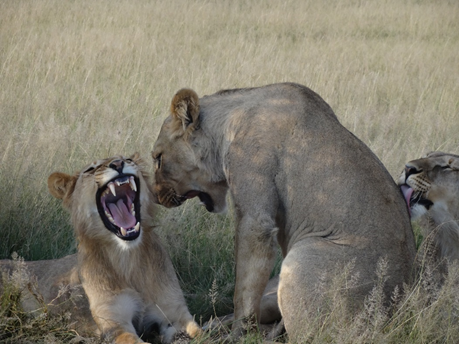This blog post is provided by Manuela González-Suárez and tells the #StoryBehindThePaper for the article “The role of brain size on mammalian population densities”, which was recently published in Journal of Animal Ecology.
An area near my home has an active sett occupied by a badger family. I have also seen a handful of deer, and dozens and dozens of squirrels. This difference in the number of individuals from distinct species that can be found in an area, the variation in local abundance or density, is a widespread phenomenon, and one that has interested ecologists for a long time. A simple explanation for this variation is that distinct organisms have different energy and resource requirements. Because a given area has finite resources, it can accommodate fewer of the organisms that have higher requirements compared to those needing less.
In theory, we could explain and predict population densities for different species based on their requirements. Although, directly measuring energy or resource requirements is not straight forward, there are useful proxies, like body size that can be used. Larger organisms require more energy to maintain their bodies (higher metabolic expenses), and thus, we predict, and indeed find, few large organisms and many small ones will live in a given area. An extensive body of ecological literature has indeed shown that population density can be predicted, to some extent, by body size (Damuth, 1981; Silva et al., 2001; White et al., 2007; Santini et al., 2018) Global Ecology and Biogeography 27, 968-979. In addition, organisms vary in how they acquire the needed energy, which in turn leads to variation in density. For example, in an African savannah, herbivores feeding on very abundant grass are more common than the carnivores that hunt them.

Overall body size influences energy needs, but it turns out not all parts of a body are equally demanding in term of energy. In mammals, for example, brains are among the most energetically demanding organs, which means that organisms with equal total body size but bigger brains need more energy (Minket al., 1981). Could this increased cost lead to lower population densities in big-brained mammals?
Because all good stories have plot twists, larger brains could also influence population density in a different way. Larger brains are associated with greater cognitive ability and innovative capacity, so big-brained organisms, even if they need more energy, may be able to compensate the costs by being “clever” about securing that energy. If that happens, we expect to find big-brained mammals occurring at higher population densities.
So we embarked in a study to answer the question: Does brain size explain variation in population density among species – and if so, in which way? We compiled data from the literature on population density, brain mass, body mass and diet of mammalian species. We were primarily interested in brain mass but body mass and diet have been shown to be important, so we needed to account for their effects. Also body mass is of course associated to brain mass (nature could not fit a whale brain in a mouse), and diet is also linked to both body and brain mass, so we needed to include these variables and their relationships to understand if and how brain size influences population density. We were able to find data for 656 terrestrial and non-volant mammals (we found data for some marine species and bats but we excluded these because population densities are harder to estimate and interpret in these less studied groups). Our sample represents about 11% of all known mammals from 20 taxonomic orders, but some groups, like carnivores and primates, are better represented than others.

As mentioned above, our predictors (brain size, body size and diet) are related to each other, so we needed to use a statistical method, Phylogenetic Path Analysis (Gonzalez-Voyer & von Hardenberg, 2014), that allowed us to propose and compare multiple direct and indirect relationships linking predictors with each other and with the response (population density). For example, we tested a model that proposed direct effects of diet and brain mass on population density and a direct effect of diet on brain mass. In this model, diet is assumed to influence population density directly, but also indirectly via its effect on brain size. An alternative model included only indirect effects of diet on population density (diet influencing brain mass and brain mass influencing density). In total, we fitted and compared 12 different models. We analyse the data for all 656 species combined, as well as for five groups: the four taxonomic orders with most data (Carnivora, Cetartiodactyla, Primates, and Rodentia) and marsupials.
Our results show that brain size explains variation in population density among species, with big-brained mammals occurring at lower population densities. We found no evidence that “being smart” compensates for the increased costs of a big brain, although it likely does in some groups, like humans. We, humans have used our big brains to maximize exploitation of resources and overcome the finite energy limitation of an area by manipulating the limits and widely importing resources across sites. On the other hand, for our closest relatives, primates, big brains are costly and linked to lower population densities.

We also found specialized diets are directly linked to lower population densities and generally, there was an effect of total body size, as expected larger mammals live at lower densities. However, direct links between body size and population density were not always supported, suggesting brain size could be a better, more direct predictor of energy requirements, at least in some groups. An alternative explanation could be that brain size is just a more accurate descriptor of size: brain size varies less across and within adults of one species than body size, but the sensitivity analyses we completed suggest this is not likely the case.
If big-brained mammals are generally found at lower population densities and lower local abundance increases local extinction risk, this could be bad news. Indeed, we found in another study that big-brained mammals have increased risk of extinction (Gonzalez-Voyer et al., (2016). Big brains have provided evolutionary advantages and may still be useful in modified anthropogenic landscapes (Santini et al., 2019), but they come with costs that ultimately may be too high. Paraphrasing Darwin, this could be survival of the thickest.
Bio: I am Associate Professor in Ecological Modelling at the University of Reading. My research interests are very broad, fitting under a large umbrella of seeking to understand and protect biodiversity. I work mostly on vertebrates, particularly mammals, and focus on data analyses often with a macroecological lens, but occasionally I conduct field research in different areas, which provides a welcome opportunity to be outside the office.
References
Damuth, J. (1981) Nature, 290, 699.
Gonzalez-Voyer, A. & von Hardenberg, A. in Modern phylogenetic comparative methods and their application in evolutionary biology (ed L.Z. Garamszegi) 201-229 (Springer-Verlag, 2014).
Gonzalez-Voyer, A. et al. (2016) Evolution, 70, 1364–1375.
Mink, J. W. et al. (1981) American Journal of Physiology-Regulatory, Integrative and Comparative Physiology, 241, R203-R212.
Santini, L. et al. (2018) Global Ecology and Biogeography, 27, 968-979.
Santini, L. et al. (2019) Ecology Letters, 22, 365-376.
Silva, M. et al. (2001) Global Ecology and Biogeography, 10, 469-485.
White, E. P. et al. (2007) Trends in Ecology and Evolution, 22, 323-330.


Great, Thanks for sharing and writing this interesting information